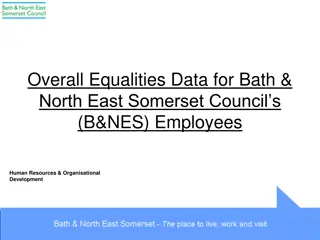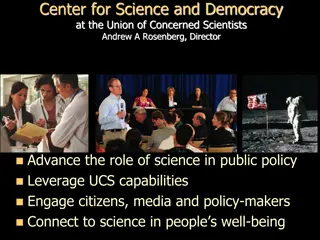Understanding Social Science Research for Non-Social Scientists at University of Bath
This resource delves into social science research fundamentals, encompassing types of inquiry, empirical research categories, primary and secondary research distinctions, and the importance of selecting a suitable research topic. It offers guidance on initiating research based on empirical observations or existing theories, emphasizes the significance of a well-defined research problem, and highlights the value of contributing to existing knowledge gaps.
- Social Science Research
- University of Bath
- Empirical Research
- Research Topic Selection
- Knowledge Contribution
Download Presentation

Please find below an Image/Link to download the presentation.
The content on the website is provided AS IS for your information and personal use only. It may not be sold, licensed, or shared on other websites without obtaining consent from the author. Download presentation by click this link. If you encounter any issues during the download, it is possible that the publisher has removed the file from their server.
E N D
Presentation Transcript
Social Science Research for Non-Social Scientists Dr. Iulia Cioroianu Department of Politics, Languages and International Studies University of Bath
Social Sciences & Humanities Political science & international studies Public and social policy Sociology Education Psychology Economics Science and Technology Studies Law & legal studies Social Development studies Environmental planning Area Studies anthropology Management & business studies Human Geography Linguistics and languages Demography Social work History Visual and performing arts Archeology Literature Classics Philosophy Religion studies
UKRI uses a very broad definition of research: any form of disciplined enquiry that aims to contribute to a body of knowledge or theory . definition of research What is social science research? Types of enquiry: Positive (describing and explaining what is ; objective and fact-based, verifiable and testable) vs. normative (value judgements about what ought to be , subjective, non-testable) What forms does it take? Theoretical/conceptual (hypothetical discussion of concepts and the relations between them) vs. empirical (applied) Empirical research can be: Exploratory (often first step in formulating questions and hypotheses) vs. descriptive (the goal is systematic description) vs. explanatory (the goal is to explain phenomena, test hypotheses, make predictions). Quantitative (using numbers and statistical methods, seeking general description, inference or test of causal hypotheses) vs. qualitative (focus on one or a small number of cases, in-depth, detailed analysis, providing a comprehensive or interpretative account of the studied phenomenon). Primary research (collecting own data) or secondary research (analysing data collected by other researchers)
Based on student interests Starting point can be: Empirical observation (personal experience, current events, media reports, etc.) Existing theories (assumes some pre-existing level of familiarity with the academic literature on the topic) A good topic: Can sustain the student s interest over the longer term Is relatively specific Can be addressed with a feasible research design (timescale, resources, word counts) Can lead to the development of research that is useful or interesting for the wider community Choosing an area of interest and defining the problem
Building upon existing knowledge and research, explain the particular contribution of the proposed research. What knowledge gap does it fill? Formulate a clearly- articulated research question or problem. Explain why it is relevant and important. Identify and specify the research context in which the question or problem will be addressed. What do existing theories say? Elements of a social science research project Specify and briefly explain the research methods to be used, and explain the rationale for their choice. Select or collect data and/or evidence. Describe the data collection process. Analyse the data and evidence, and present the results of the analysis. Discuss the generalizability potential and implications, but also the limitations of the research conducted. Briefly suggest potential future areas of enquiry. Discuss and interpret the results in relation to existing literature and theories.
Building upon existing knowledge and research, explain the particular contribution of the proposed research. What knowledge gap does it fill? Formulate a clearly- articulated research question or problem. Explain why it is relevant and important. Identify and specify the research context in which the question or problem will be addressed. What do existing theories say? Literature review Introduction Elements of a research paper or report Specify and briefly explain the research methods to be used, and explain the rationale for their choice. Select or collect data and/or evidence. Describe the data collection process. Analyse the data and evidence, and present the results of the analysis. Methodology Results Discuss the generalizability potential and implications, but also the limitations of the research conducted. Briefly suggest potential future areas of enquiry. Conclusion Discuss and interpret the results in relation to existing literature and theories. Discussion
It depends on the type of output Research paper Report Blog post or media briefing, etc. Standard structure for a research paper: What proportion does each section take in the final output? Abstract (if needed) Introduction: ~10% Literature review: 20-25% Data and methods: 10-20% Results & discussion: 35-40% Conclusion: ~10% References Appendices (if allowed or needed)
A good social science research question literature review data collection data analysis interpretation and discussion of results links back to the literature review and the identified theories, clearly explaining how the research conducted informs those debates conclusion is socially and scientifically relevant builds upon existing knowledge is amenable to investigation and narrow enough uses academic sources (academic journal articles, books, scientific reports, etc.) uses research databases (Google Scholar, JSTOR, Web of Science) identifies the main theory or theories that the research engages with uses appropriate sources and collection methods quantitative data: survey data, official statistics, experiments qualitative data: interviews, participant observation, ethnography, focus groups uses appropriate methods for analysing the collected data shows the ability to place the research within the broader social and academic context critically evaluates the implications of the results discusses limitations can suggest future areas of enquiry
Relevant for all projects, but in particular those in which the researcher interacts with human subjects Principles: No harm. Proportionality of any negative effects Consent, debriefing and subject right to withdraw from the research Case-by-case: confidentiality, privacy and/or anonymity Research ethics Included in the appendix or briefly mentioned in the methodology section
Walliman, N. (2021). Research Methods: The Basics (3rd edition). Routledge. Adams, J., Khan, H. T. A., & Raeside, R. (2014). Research Methods for Business and Social Science Students. SAGE Publications. Bhattacherjee, A. (2012). Social science research: Principles, methods, and practices. Guthrie, G. (2010). Basic Research Methods: An Entry to Social Science Research. SAGE Publications. Resources Labaree, R. V. (n.d.). Research Guides: Organizing Your Social Sciences Research Paper: Purpose of Guide [Research Guide]. Retrieved June 16, 2022, from https://libguides.usc.edu/writingguide/purpose Pasek, J. (2012). Writing the Empirical Social Science Research Paper: A Guide for the Perplexed. https://www.researchpublishers.org/pdf/56/Empirical- Social-Science-Research-Paper.pdf Writing in the Social Science Format.pdf. (n.d.). Retrieved June 16, 2022, from https://www.una.edu/writingcenter/docs/Writing- Resources/Writing%20in%20the%20Social%20Science%20Format.pdf Toshkov, D. (2016). Research Design in Political Science. Macmillan International Higher Education.

 undefined
undefined



































